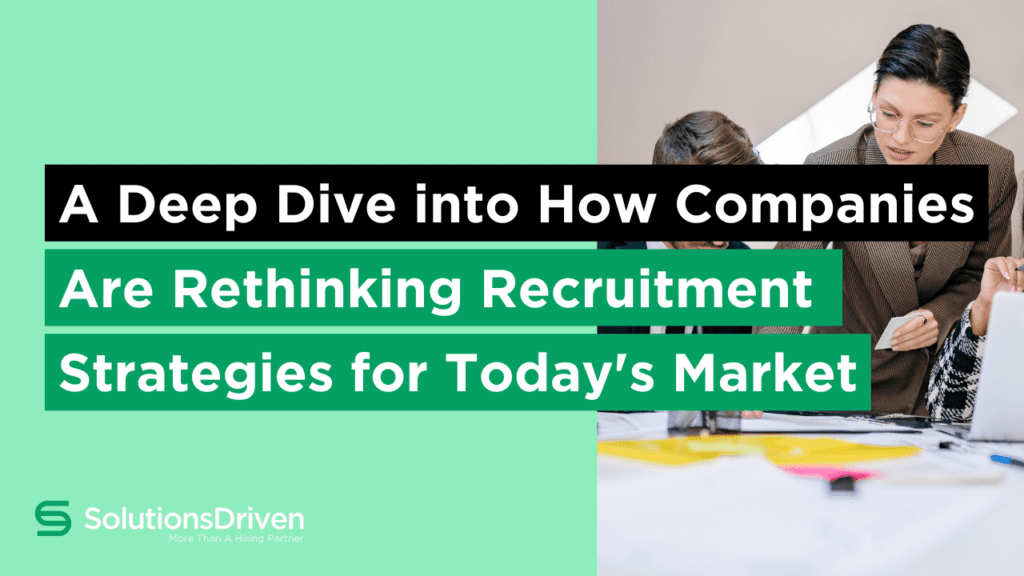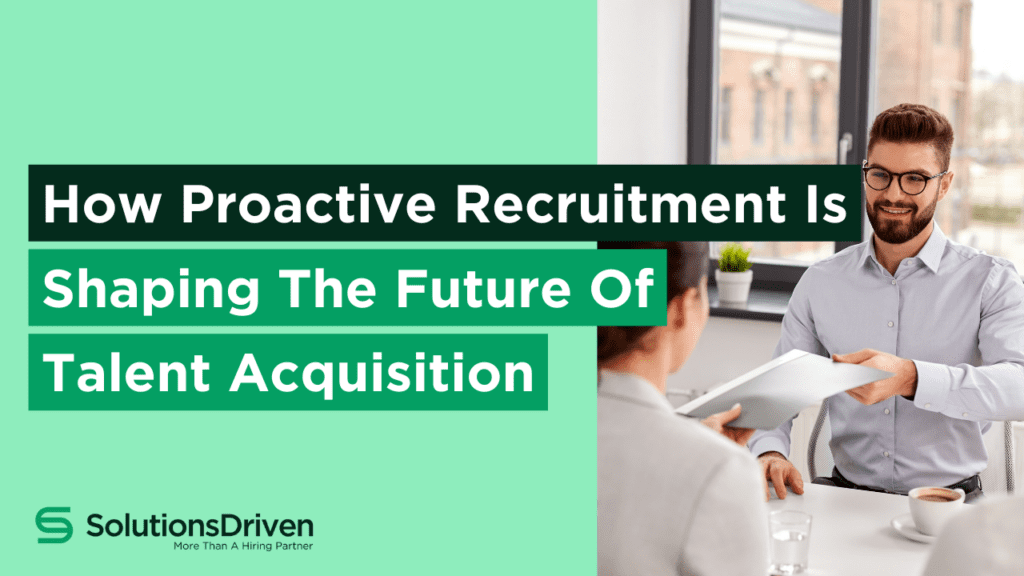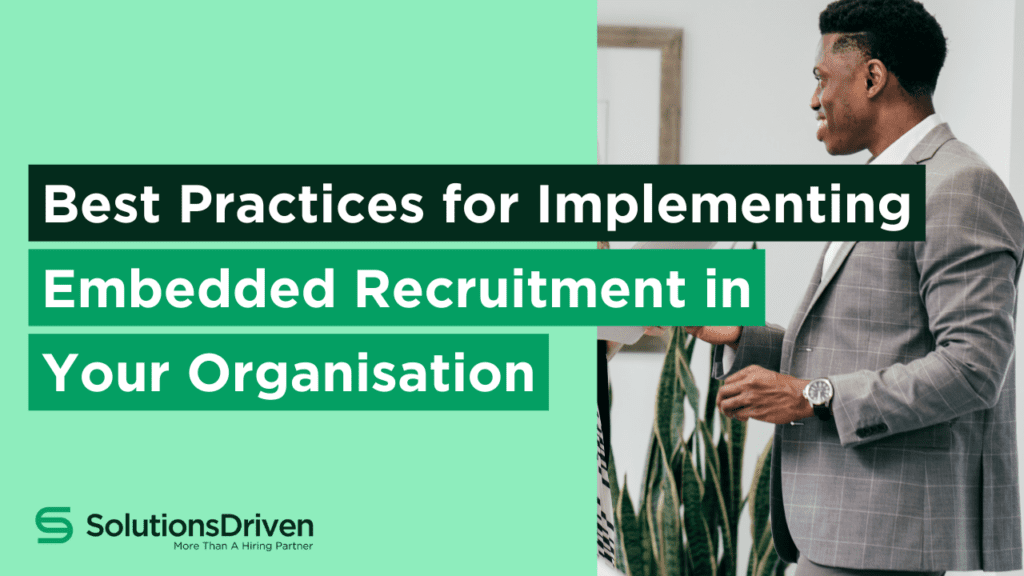To be the first to hear about our latest blogs, whitepaper releases, hiring enablement podcast episodes and get exclusive event invites, join our Exclusive Hiring Enablement Community.
In business, it can feel like the only constant is change. And as market dynamics continue to reshape the corporate landscape, traditional recruitment strategies are being challenged like never before. From within this turbulence, companies are striving to rethink and reinvent their approach to talent acquisition.
And that’s why we’ve written this blog. Here we’ll explore some of the innovative recruitment strategies that some of the most successful companies are employing. Plus, how these strategies are revolutionising the way we think about staffing. From using AI to embracing diversity, these changes are not just responses to challenges but, in fact, opportunities for growth and transformation.
Read on as we delve deeper into the eye of the storm, unveiling the future of recruitment, and providing you with the insights needed to not only weather it but come out stronger.
The Evolving Work Landscape
In the rapidly changing business environment, we’ve witnessed a seismic shift in how work is defined and delivered. It was the subject of our recent downloadable white paper, The Evolution of Recruitment Strategies in a Dynamic Market. From global pandemics to technological advancements, numerous factors have disrupted traditional business models, demanding an agile and forward-thinking approach to staffing. Companies must now think outside the box, embracing new ways of working and collaborating.
One of the most significant changes has been the rise of remote work. Once a perk, working from home has become the norm for many businesses, with people in the UK spending an average of two days per week working remotely. This shift has expanded the talent pool beyond geographical boundaries, but it’s also introduced new challenges in attracting, managing, and retaining talent.
As we look ahead, several trends are likely to shape the future workforce. These include the increasing importance of soft skills, the integration of AI and automation in the workplace, and the growing emphasis on diversity and inclusion. As these trends continue to evolve, companies must adapt their recruitment strategies accordingly.
Challenges in Traditional Recruitment
Despite being tried-and-tested, traditional recruitment methods aren’t without their hurdles – and especially in today’s dynamic market. Some of the most common challenges include identifying the right talent, lengthy hiring processes, and adapting to the changing expectations of job seekers. And in a candidate’s market, where top talent often has multiple options, these challenges can be significant barriers to effective hiring.
Traditional recruitment approaches often lack the flexibility and creativity needed in today’s market. They may struggle to tap into new talent pools, accommodate remote working arrangements, or effectively assess soft skills. So the key to remaining competitive is, rethinking these approaches, and exploring innovative ways to attract and retain the best talent.
Innovative Recruitment Strategies
So, what do innovative recruitment strategies look like? Here are just a few examples of the kinds of strategies we’re seeing businesses embrace to stay ahead.
A. Embracing Technology in the Hiring Process
Tech has revolutionised hiring, making it faster, smarter, and more efficient.
AI and machine learning, for instance, are transforming candidate sourcing by automating time-consuming tasks and providing data-driven insights. These technologies can sift through vast amounts of data to identify high-potential candidates, reducing bias and improving hiring outcomes.
And then due to the rise of remote work, video interviews and virtual assessments have become indispensable tools. They allow companies to assess candidates from anywhere in the world, reducing time-to-hire and expanding the talent pool.
B. Flexible Talent Acquisition Models
As work becomes more project-based and transient, flexible talent acquisition models are gaining traction. The gig economy is reshaping the workforce, with more professionals choosing freelance work for its flexibility. At the same time, 44% of leaders expect to increase their use of freelancers, according to a survey by The Forrester Business and Technology Services. It’s a great solution for companies to tap into an extensive talent pool for specific projects or skills, increasing agility and reducing costs.
There’s project-based hiring too, which allows companies to bring in experts for specific tasks or projects. This approach provides access to specialised skills, promotes diversity of thought, and enables companies to scale their workforce as needed.
C. Building a Diverse and Inclusive Workforce
Diversity and inclusion are no longer optional—they’re essential for success in today’s global market. A diverse workforce brings a range of perspectives, encouraging innovation and resilience. And it enables companies to better understand and serve their diverse customer base and navigate uncertainties in the market.
Inclusive recruitment practices involve creating a fair and unbiased hiring process. This could include blind recruitment, offering flexible working arrangements, and ensuring diversity in recruitment panels. By creating an inclusive environment, companies can attract a wider range of talent and drive better business outcomes.
Case Studies
Leading by example, here are a couple of businesses that have adapted to the dynamic talent acquisition landscape.
Case Study 1: IBM’s People-Focused Approach
IBM, a multinational technology company, has always been at the forefront of innovation, not just in terms of technology but also in their approach to talent acquisition. Recognising the importance of skills over degrees, IBM has shifted its focus towards candidates’ skills rather than their educational background. This has led to a broader, more diverse pool of talent.
IBM also utilises AI in their recruitment process through their AI tool, Watson, which helps them streamline candidate sourcing, improve job matching, and even predict future hiring needs.
Case Study 2: Starbucks’ Commitment to Inclusion
Starbucks, the global coffeehouse chain, has set an excellent example when it comes to inclusive hiring practices. The company launched a dedicated initiative to hire refugees, demonstrating a commitment to social responsibility and diversity.
They also invest heavily in employee development and training, offering programs like the Starbucks College Achievement Plan, which provides employees with the opportunity to earn a degree with full tuition coverage. Such initiatives not only attract a wide range of candidates but also foster employee loyalty and engagement.
These case studies show that innovative recruitment strategies can provide significant benefits, from a diverse and skilled workforce to improved employer branding.
Reskilling and Upskilling Initiatives
In this rapidly changing business environment, investing in employee development isn’t just beneficial—it’s completely necessary. As technological advancements continue to reshape industries, the skills needed to thrive are evolving. And if you’re able to recognise this shift and invest in reskilling and upskilling your workforce, you’ll be better positioned to navigate these changes.
Implementing employee development programs not only equips employees with the skills they need to succeed but also demonstrate a company’s commitment to its workforce. Did you know that 92% of candidates say that developmental opportunities are a deciding factor when looking for a new role? So, by investing in these kinds of programs, you’ll improve employee engagement, productivity, and retention.
Remember, the market’s skill requirements are not static—they’ll change as new technologies emerge and industry trends evolve. So, regularly updating employee development programs to reflect these changes are the only way to ensure you’re maintaining a competitive edge.
The Role of HR and Leadership
Another key element of effective recruitment strategies is collaboration between HR and leadership. HR brings expertise in talent acquisition, while leadership provides strategic direction. Together, they’ll develop recruitment strategies that align with the company’s goals and adapt to the changing market conditions.
A culture of adaptability and continuous learning is crucial in today’s dynamic business environment. And both HR and leadership play key role in nurturing this culture, promoting a growth mindset, and encouraging employees to embrace change.
Top executives are the individuals who set the tone for the entire organisation. By prioritising diversity, demonstrating a commitment to employee development, and embracing innovative recruitment strategies, they can significantly influence the company’s talent acquisition efforts.
Future Outlook
As we look ahead, it’s crucial to consider what the future may hold for staffing in dynamic markets.
Firstly, the future of staffing is expected to be even more flexible and tech-driven. Companies will likely rely more on remote work, gig workers, and AI-powered recruitment tools. And diversity and inclusion will continue to play a significant role, as companies realise the value of a diverse workforce.
But we also predict that AI and machine learning will become increasingly sophisticated, further automating the recruitment process, and reducing bias. Virtual reality could also play a role, providing immersive job previews and training programs, while data analytics will be used more extensively to predict hiring needs and assess candidate fit.
So, in conclusion it’s important to prepare for future uncertainties by investing in employees through reskilling and upskilling initiatives. It’s time to embrace technology, and to leverage AI and data analytics to streamline your recruitment process. Finally, if you’re not doing so already, work on building a culture of adaptability, encouraging your employees to embrace change and continuously learn.
The dynamic nature of today’s markets requires equally dynamic staffing strategies. We’ve seen how companies like IBM and Starbucks have successfully adapted their recruitment strategies in response to changing market conditions. We’ve also discussed the importance of reskilling and upskilling initiatives and the role of HR and leadership in strategic recruitment.
But the ultimate key to success in this ever-changing landscape? It’s continuous adaptation. Companies must be willing to evolve their staffing strategies, embracing new technologies, fostering a culture of continuous learning, and prioritising diversity and inclusion. Only by doing so will you continue to navigate uncertainties and position yourself for long-term success.
If you want to learn more about navigating the ever-changing world of talent acquisition, why not download our white paper, The Evolution of Recruitment Strategies in a Dynamic Market? Alternatively, as experts in recruitment, we’re always hereto help you to remain competitive. Contact the team at Solutions Driven today.







